Upanayan (Vratabandha, Munja [The ritual of thread ceremony]) – Ninth Sanskar
Contents [hide]
- 1. Definition and synonyms
- 2. Objectives
- 3. Importance
- 4. Importance of a shikha(Tuft) and a sutra(Sacred thread)
- 5. Eligibility
- 6. Preparations
- 7. Sankalpa of the boy undergoing the thread ceremony
- 8. Sankalpa of the one performing the thread ceremony
- 9. Invoking the Mandapdevata (Deity of the mandap)
- 10. Keshvapan (Shaving the head), bathing and applying vermilion
- 11. Gifts from the family and its importance
- 12. Muhurtghatika sthapana (Ritual of installation of the pot to denote the auspicious time)
- 13. Matrubhojan(Last meal with the mother)
- 14. Performing the thread ceremony
- 15. Vastradharan (Wearing a loin cloth and new clothing)
- 16. Ajindharan (Wearing deerskin)
- 17. Yadnyopavitdharan (Wearing the sacred thread)
- 18. Avaksharansankalpa (Sankalpa of establishing the discipleship)
- 19. Vibhutigrahan (Application of Holy ash)
- 20. Upasthan (Gayatri) mantragrahan (Prayer to receive the Gayatrimantra)
- 21. Mekhalabandhan (Tying of the girdle)
- 22. Dandadharanvidhi (Ritual of holding the staff)
- 23. Acharbodhand Batu vrat
- 24. Bhikshagrahan (Begging for alms)
- 25. Mandapdevakotthapan (Farewell to the Deity of the mandap)
- 26. Dharmamunja
1. Definition and synonyms
1. The word Upanayan consists of two words, ‘upa’ and ‘nayan’. ‘Upa’ means near and ‘nayan’ means to take towards. In short, Upanayan means taking one to the Guru, who will teach the Gayatrimantra. Nayan also means ‘the eye’. Upanayan thus means the inner vision (antahachakshu). Therefore, the ritual which facilitates the development of inner vision is called Upanayan.
2. Vratabandha is that ritual by which one is bound by restrictions of religious observances, norms of Dharma and celibacy. Before that, there are no restrictions on the child’s behaviour. Brahmacharya(Celibacy) means merging into Brahman, the God Principle which is in the form of ultimate knowledge.
3. Since in the sanskar of Upanayan a grass named ‘munja’, is tied to the waist during the ceremony, the ritual is also referred to as Munja. The one on whom the ritual is being performed is called a batu (One whose thread ceremony is being performed), brahmachari etc. However, after the ritual he is called an ‘upanit’.
2. Objectives
Every human being is born a Shudra, that is, learns how to clean himself physically. Later, by performing rituals (karma) he becomes dwij, that is, he is reborn. ‘Dwi’ means two, and ‘j’ means to be born. Due to the thread ceremony, since the boy has a kind of rebirth, he is said to have been twice born (dwij). The second birth of a celibate is marked by the ritual of the thread ceremony. It is symbolised by wearing a girdle of munja grass. In this birth, Savitri is considered to be his mother and Acharya (A spiritual guide or the teacher), his father. (Manusmruti2.170) Once he becomes dwij, he becomes eligible to chant the Gayatrimantra, that is, qualifies to perform sadhana(Spiritual practice); hence, performing the thread ceremony is a must, but marriage is not.
3. Importance
‘Upanayan sanskar is meant for the boy to develop a code of conduct towards everyday life and imbibe the knowledge essential for it. In the earlier times, the boy was required to live with the family of a Sage for 12 years. There he would receive education of all kinds – the 4 Vedas, 64 Kalas (Arts), Upanishads, archery and Ayurveda. Thus, a perfect seeker accomplished with knowledge would become capable to lead his future life.’
– H.H. Pande Maharaj, Sanatan Ashram, Devad, Panvel, Maharashtra.
4. Importance of a shikha(Tuft) and a sutra(Sacred thread)
‘Shikhasutra’ is the symbol of Hindus. It is secondary and not the only identity of Dharma. The Sanatan Hindu Dharma is all-encompassing. Yet shikhasutra are the life of Hindu culture. No religious ritual can be performed without them.
5. Eligibility
A.The age at which the upanayana should be done according to the varna.
According to ‘Ashwalayangruhyasutra’ (Chapter 19, Sūtra 1-4), this ritual should be performed during the eighth year in a Brahman, the eleventh year in a Kshatriya and the twelfth year in a Vaishya. This is because to perform a thread ceremony, the minimum requirement of the Sattva component is 30%, and a child of the respective class can achieve it at that particular age, as provided in the table ahead.
B.Girls too had the right to this sanskar
‘In the ancient times the thread ceremony was performed in girls as well. A mention of this is found in the Kurmapuranaas,
पुराकल्पेहिनारीणांमौजीबन्धनमीरितम् ।
Meaning : In the ancient times, the thread ceremony was performed for girls as well. The father, paternal uncle or brother would impart knowledge to the girl. However, other men were prohibited from performing this task. A celibate girl begged for alms in her own house. Manu (states that the thread ceremony was performed for girls without the recitation of mantras. From this, it appears that since Manu’s times this custom began to slowly decline.
6. Preparations
One day before the thread ceremony (or three days in advance), the boy should remain on a diet of milk only. This increases the Sattva component in him.
7. Sankalpa of the boy undergoing the thread ceremony
‘I will absolve myself from the sins of my unrestrained behaviour, talk, eating, drinking etc., by performing three intense penances or by donating money.
8. Sankalpa of the one performing the thread ceremony
‘I will chant the Gayatrimantra 12,000 times to become eligible to perform the ritual of Upanayan of this boy. As part of the ritual I will perform a grahayadnya in order to acquire their favour and to venerate Parameshwar’. The first right to perform thread ceremony of his son goes to the father. After it is decided to perform the thread ceremony, the Gayatrimantra is chanted 12,000 times.
9. Invoking the Mandapdevata (Deity of the mandap)
‘Bruhaspati is the chief Deity of the thread ceremony. The objective of invocation of the Deity of the mandap and Ganapati, the vanquisher of obstacles, before beginning any sanskar like marriage, thread ceremony etc. is to overcome obstacles.
10. Keshvapan (Shaving the head), bathing and applying vermilion
Expressing a resolve – ‘Before performing the thread ceremony of this child, I will shave his head (also known as Keshvapan)’. The boy’s head should be shaved, he should be bathed and his hair tied in a shendi. (If the sanskar of Choulkarma is performed along with the thread ceremony, then there is no need to make a sankalpa as the hair are already cut earlier). The tuft of hair is also called shikha, its knot is called shikhagranthi and the act of tying it is called shikhabandhan. After this a tilak (Spot) of vermilion is applied to the boy’s forehead.
11. Gifts from the family and its importance
Entering the house to the accompaniment of auspicious music, make three mounds of rice in the north-east direction and invoke Deities Bhagawati, Matruka and the winnow with the avighnakalash, one on each mound.
Amidst recitation of two mantras
‘तदस्तु मित्रावरुणा0’
ह् ‘गृहा वै प्रतिष्ङ्गासूक्तं0’
perform puja of these Deities with gandha, akshata, flowers etc. Then, married women should perform ovaḷani for the host and his wife and after that relatives, friends and well-wishers should offer them gifts
12. Muhurtghatika sthapana
(Ritual of installation of the pot to denote the auspicious time)
A. Sankalpa
‘I install this ghatika yantra as a device to know the auspicious time to perform the thread ceremony of my son.’
B. The ritual
Place a copper vessel on a mound of rice or any other food grain. After reciting the mantra ‘तदस्तु मित्रावरुणा0’ ‘गृहा वै
प्रतिष्ठासूक्तं0’, pour water into the copper vessel and then place the ghatika yantrain it. At that time, recite a mantra which means, ‘O yantra, the chief among the yantras, Deity Prajapati created you in the beginning. I am now invoking you here in order to attain good fortune, longevity, health, good progeny and wealth. May we accomplish it with this’.
Note : Nowadays, since there are clocks the ghatika yantra is no longer installed.
13. Matrubhojan(Last meal with the mother)
This is the last meal that a boy takes from his mother’s plate, as he is now going to be reborn and will be away with the Guru. Eight boys who have not undergone the sanskar, are fed a meal. This is called ashtavarga (ashta means eight).
14. Performing the thread ceremony
An antarpat (Curtain) is held between the father and the son whose thread ceremony is being performed and the mangalashtake (Eight auspicious verses) are recited. The father who teaches the son the Gayatrimantra is considered to be his first Guru (or teacher). The antarpat between the father and the son is removed, thus reducing the distance between them. In the earlier times, after the thread ceremony the children would go to their Guru to undertake their studies. On the completion of the mangalashtake, when the word ‘savadhan’ was uttered, the parents would become aware that their son was now going to be separated from them, and would become anxious. Since the mother grieved about the separation more than the father, during the recitation of the mangalashtake it was customary for the mother to stand away from the boy. There is no implied scriptural meaning behind this.
15. Vastradharan (Wearing a loin cloth and new clothing)
Tie a triple-folded thread onto the waist of the boy and make him wear a loin cloth. The three strands of thread represent the triguna (Three components), while the tying of the loin cloth symbolises celibacy and keeping these three components in control. Then, reciting a mantra dress the boy in new, white clothing. Subsequently, repeating the same mantra, give him a yellow cloth to drape himself. White depicts purity while yellow, radiance of a Brahman. New clothing is used as being unused, it is free from impressions of another.
16. Ajindharan (Wearing deerskin)
The boy should be made to wear a deerskin after reciting a mantra. Usually deerskin is used, as later he is supposed to use it as a seat to perform sadhana.
17. Yadnyopavitdharan (Wearing the sacred thread)
The sacred thread is held in the hand and chanting the Gayatrimantra ten times, is sprinkled with water charged with the mantras. This bestows it with the Tejtattva. The boy is then made to wear it.
18. Avaksharansankalpa (Sankalpa of establishing the discipleship)
The priest expresses the sankalpa – ‘I am performing the ritual of Ayanjaliksharan to purify the boy and to appease Deity Savitr (Sun Deity). In this ritual, the name of the boy decided on the basis of the first charan of his birth lunar asterism is whispered into his right ear.
19. Vibhutigrahan (Application of Holy ash)
Reciting the mantra ‘मानस्तोके0’ take the vibhuti in one hand and apply it to the relevant parts of the boy’s body – त्र्यायुषं जमदग्ने: (forehead), कश्यपस्य त्र्यायुषं (neck), अगस्त्यस्य त्र्यायुषं (navel), यद्देवानां त्र्यायुषं (right shoulder), तन्मे अस्तु त्र्यायुषं (left shoulder) and सर्वमस्तु शतायुषं (hollow in the scalp). The vibhuti generates vairagya (Detachment).
20. Upasthan (Gayatri) mantragrahan
(Prayer to receive the Gayatrimantra)
The meaning of this ritual is – ‘Please teach me the Gayatrimantra’. Then the following mantra is taught.
ॐ भूर्भुवः स्वः तत्सवितुर्वरेण्यं भर्गो देवस्य । धीमहि धियो यो नः प्रचोदयात् ।
21. Mekhalabandhan (Tying of the girdle)
Wind the girdle around the waist of the boy undergoing the thread ceremony thrice and then join the ends in three knots near his navel. At that time, the batu should become aware that by studying the application of the ‘Aranyaks’ (to be recited in the forest) and the ‘Upanishads’, which are part of the six parts of the three Vedas, he is bound to their study.
22. Dandadharanvidhi (Ritual of holding the staff)
A staff is handed over to the batu after reciting a mantra. At that time the batu should say, “I am holding this staff which will suppress ‘I’ who am impudent (The boisterous one who does not pay heed to another) and which will make me follow the righteous path. May it protect me from that which may induce fear.” The staff is an upright branch from the top of a palas tree. It converts negative energies from the atmosphere into pleasant ones.
23. Acharbodhand Batu vrat
A. Acharbodh (Code of conduct preached by the priest)
‘Since you are a celibate you should observe the following rules :
1. For maintenance of purity perform achaman after passing urine or stools, eating, travelling and sleeping.
2. Perform the nityakarma (Regular actions) of sandhya, worship, fire sacrifice etc. everyday.
3. Do not sleep during the day.
4. Recite the Vedas under the guidance of a teacher.
5. Beg for alms in the morning and evening.
6. Offer sacrificial firewood to the fire in the morning and evening.
7. Observe celibacy for twelve years or until the completion of the study of the Vedas.
8. Beg for alms only from a man or woman who will not let you return empty-handed.’
After explaining this code of conduct that part of the sacrificial fire from ‘यदस्यकर्मणो0’ should be completed.
B.Batuvrat
It includes, following the code of conduct preached by the priest, refraining from eating salty food, sleeping on the floor instead of the bed etc. Various rules and regulations other than those which the batu has to follow are described in the Smrutis.
24. Bhikshagrahan (Begging for alms)
The batu should ask for alms of rice sufficient only to perform the anupravachaniya fire sacrifice and for a meal of the priest. He should first go to the mother and say, ‘Give me alms’ ॐ भवती भिक्षां देहि ।’ He should repeat the same to the father, then the maternal aunt, elder sister and relatives, collect alms and hand them over to the priest. (In the absence of parents, a maternal aunt or sister, he can ask anyone else for alms.) Hereafter, he loses his right to be pampered by his parents and relatives.
25. Mandapdevakotthapan (Farewell to the Deity of the mandap)
Bid farewell (known as utthapan) to the Deities on the 2nd, 4th, 5th, 7th, 8th or 10th day from the day of their invocation.
26. Dharmamunja
Dharmamunja means bearing the expenses of performing the thread ceremony of a poor boy.

 Garbhadhan (Rutushanti) – First Sanskar
Garbhadhan (Rutushanti) – First Sanskar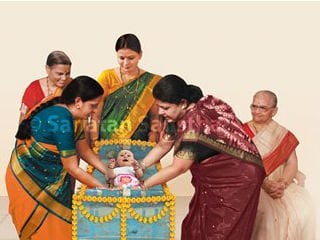 Namakaran (Naming ceremony)
Namakaran (Naming ceremony)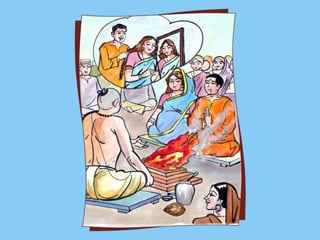 Simantonnayan (Parting the wife’s hair) -Third sanskar
Simantonnayan (Parting the wife’s hair) -Third sanskar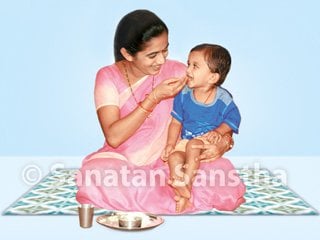 Sanskars performed after the birth of a child ! (Fourth, Fifth, Sixth and Seventh Sanskar)
Sanskars performed after the birth of a child ! (Fourth, Fifth, Sixth and Seventh Sanskar)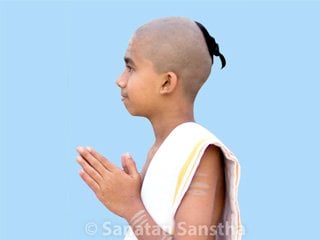 Choulkarma (Chudakarma) – keeping a shendi !
Choulkarma (Chudakarma) – keeping a shendi !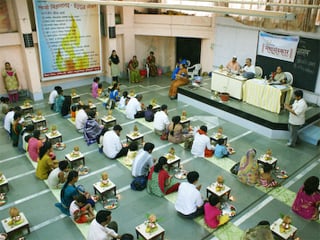 Medhajanan (Palsola vidhi)
Medhajanan (Palsola vidhi)
Wht is the Significance of the six strands
In yagyopavit
Namaskar Shri. Vivekanand Thakur ji,
Yadnyopavit has 3 threads in total and not 6. Each thread is made of 3 threads. That means the yadnyopavit is made up of total 9 threads.
The 9 threads are of Omkar, Agni, Nag, Soma, Pitru, Prajapati, Vayu, Surya, Vishvedev respectively.
Also the 3 main threads and its brahmagaath (ब्रह्मगाठ [knot]) have the presence of the 4 Vedas in it.